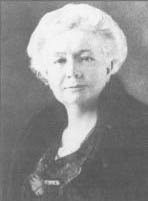Anna Sutherland Bissell
Anna Sutherland Bissell, upon her death in 1934, was acclaimed as “a successful business woman in an era where business was almost wholly a masculine field. “In addition to her significant achievements in business, Anna Bissell was involved actively in any project which attracted her interest and which she thought was important to the Grand Rapids community.”
Her early journey toward her productive business and civic life began in Du Pere, Wisconsin, where her family had settled after leaving Nova Scotia. Completing all the formal education available to her, she became a teacher at age sixteen. Three years later, at age nineteen, she married Melville R. Bissell and settled in Kalamazoo, MI. From the beginning of their marriage, she was a joint partner in their crockery and china business. By 1871, seeking greater business opportunities, the young couple relocated in Grand Rapids.
After Melville Bissell invented the carpet sweeper in 1876, Anna Bissell became a star salesperson, going from town to town and selling the popular carpet sweepers for the price of $1.50. On a trip to Philadelphia, she personally persuaded John Wanamaker to sell the Bissell sweeper in his department stores. It was Anna Bissell who organized the details of making, assembling, and delivering orders for the sweepers as well.
When a fire struck the first manufacturing plant in 1883, she sought loans from local banks to keep the business going. On only her handshake and a good name, she secured funding that enabled production to begin again within 20 days of the fire.
After Melville Bissell’s untimely death in 1889, Anna Bissell became chief executive officer of the corporation. It was said of her that “she studied business the way other women other times studied French.” During her long tenure as president (1889-1919) and chair of the board (1919-1934), Anna Bissell was known for her familiarity with every aspect of the business. She introduced progressive labor relations policies, including workmen’s compensation insurance and pension plans, long before these practices were widespread in industry. Her reputation for fairness and personal concern for individuals in her work force engendered a lasting loyalty in her employees.
Having established new guidelines on trademarks and patents, Anna Bissell moved the company into the international market, By 1899 she had created the largest corporation of its kind In the world.
As the mother of five children, Anna Bissell shouldered family as well as civic responsibilities. In the early days of her widowhood, she coped with her grief by seeking out others “more unhappy than [she was].” This philosophy led to her involvement in many worthwhile social endeavors. One of these was Bissell House, a recreation and training program for Grand Rapids youth and immigrant women.
She served on the board of what was to become Blodgett Home for Children, now called D.A. Blodgett Services for Children and Families, and she actively did some of the work associated with the adoptions of children herself. Another civic interest of this remarkable woman was hospital work through the Union Benevolent Association, the fledgling hospital that was the forerunner of the present Blodgett Memorial Medical Center. She also served on the board of Clark Memorial Home and was for years the sole woman member of the National Hardware Men’s Association.
At the time of Anna Sutherland Bissell’s death, newspaper reports called her “a business executive without peer, a respected and beloved philanthropist, and a true matriarch in her family.” The tribute was well earned by a lifetime of dedicated work.

